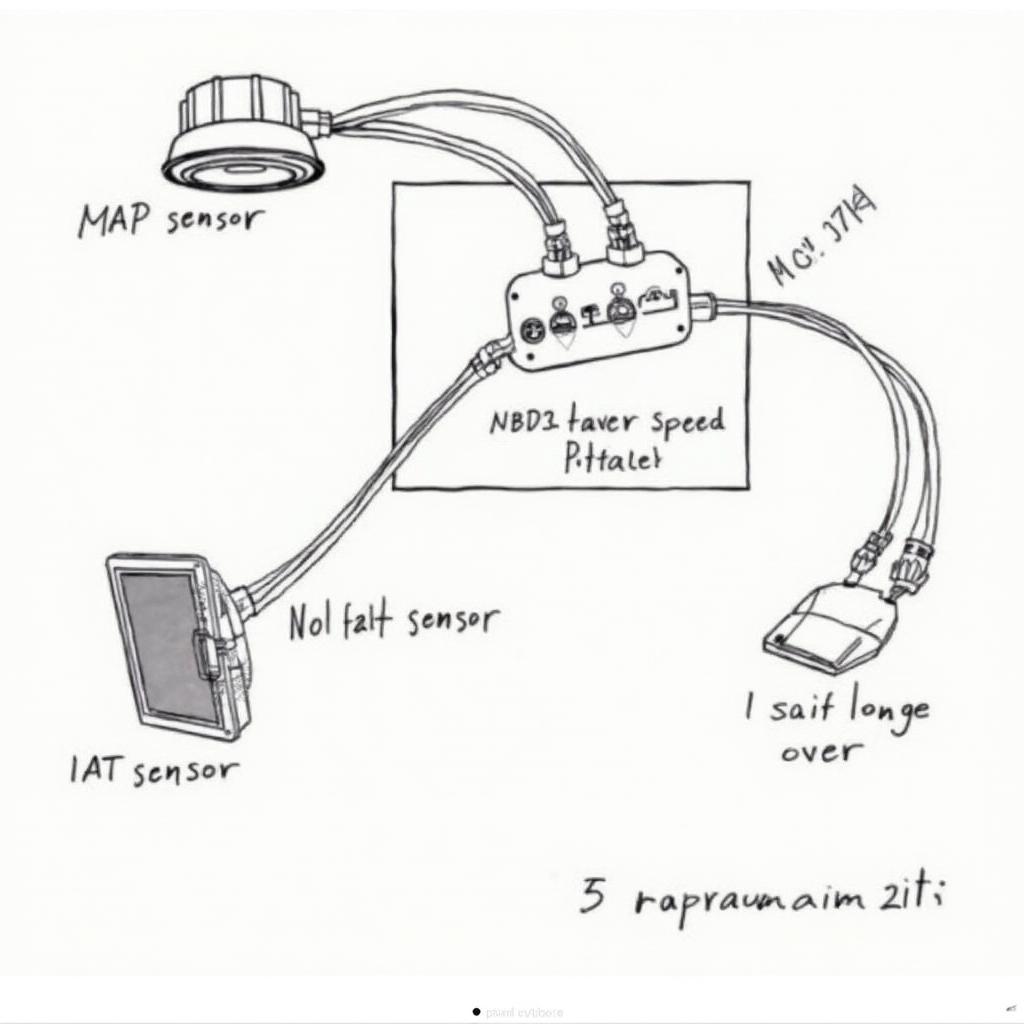Corvette speed density OBD2 systems are a crucial aspect of these iconic vehicles. Understanding how they work, their benefits, and potential issues can empower you to diagnose problems and maintain peak performance. This guide dives deep into the world of Corvette speed density OBD2, providing valuable insights for both enthusiasts and professionals.
Understanding Corvette Speed Density OBD2 Systems
The speed density system in a Corvette utilizes the OBD2 port to calculate airflow based on manifold absolute pressure (MAP), intake air temperature (IAT), and engine RPM. Unlike mass airflow (MAF) systems that directly measure airflow, speed density systems infer it. This calculation is then used to determine the appropriate fuel delivery for optimal combustion.
Advantages of Speed Density
- Simplicity: Speed density systems have fewer components than MAF systems, leading to potential cost savings and easier troubleshooting.
- Potential for Tuning: Modifying the engine, like adding a camshaft, often requires tuning adjustments with MAF systems. Speed density can offer more flexibility in these situations.
- No Restriction in Airflow: Without a MAF sensor in the intake tract, there’s less restriction to airflow, potentially leading to slight performance gains.
Disadvantages of Speed Density
- Sensitivity to Changes: Changes in atmospheric pressure, altitude, and temperature can affect the accuracy of the speed density calculations.
- Potential for Inaccuracy: Since airflow is calculated and not directly measured, there’s a higher chance of inaccuracies compared to MAF systems. This can lead to less than ideal fuel delivery and potential performance issues.
- Difficulty Diagnosing Issues: Pinpointing the root cause of a problem can be more challenging with speed density as multiple factors influence the calculations.
Common Issues with Corvette Speed Density OBD2
Several issues can arise with Corvette speed density OBD2 systems. Recognizing the symptoms is the first step towards effective diagnosis and repair.
- Rough Idle: A fluctuating or unstable idle can indicate a problem with the MAP or IAT sensors, or a vacuum leak affecting pressure readings.
- Poor Fuel Economy: Inaccurate airflow calculations can lead to excessive fuel consumption.
- Hesitation or Stumbling: This can be caused by incorrect fuel delivery due to faulty sensor readings or vacuum leaks.
- Check Engine Light: The OBD2 system will trigger a check engine light if it detects a problem with the speed density system or related components. Retrieving the trouble codes with an OBD2 scanner is essential for accurate diagnosis.
Diagnosing Corvette Speed Density OBD2 Problems
Diagnosing speed density issues requires a systematic approach:
- Retrieve Trouble Codes: Use an OBD2 scanner to identify any stored diagnostic trouble codes (DTCs). These codes provide valuable clues about the nature of the problem.
- Inspect Vacuum Lines: Check all vacuum lines for leaks or damage. A vacuum leak can significantly affect MAP sensor readings and disrupt fuel delivery.
- Test MAP and IAT Sensors: Use a multimeter to test the voltage output of the MAP and IAT sensors. Compare the readings to manufacturer specifications to determine if the sensors are functioning correctly.
Expert Insights from John Davis, Automotive Diagnostics Specialist
“When diagnosing speed density issues, remember that multiple factors can contribute to the problem. A systematic approach, starting with retrieving trouble codes and inspecting vacuum lines, is crucial.”
Tuning Corvette Speed Density OBD2
Tuning a Corvette’s speed density system allows for optimizing performance and fuel efficiency, especially after modifications like camshaft upgrades or forced induction. Tuning involves adjusting the fuel and ignition maps based on data logged from the OBD2 port.
Expert Insights from Sarah Miller, Performance Tuning Specialist
“Tuning a speed density system requires a deep understanding of how changes in MAP, IAT, and RPM affect airflow and fuel delivery. Proper data logging and analysis are essential for achieving optimal results.”
Conclusion
Corvette speed density OBD2 systems offer a unique approach to managing engine performance. While they have advantages like simplicity and tuning potential, they also require careful attention to diagnosis and maintenance. By understanding how these systems work and using the right diagnostic tools, you can ensure your Corvette runs smoothly and efficiently.
FAQ
- What is speed density? Speed density is a method of calculating airflow based on manifold absolute pressure, intake air temperature, and engine RPM.
- How does speed density differ from MAF? MAF systems directly measure airflow, while speed density systems calculate it.
- What are common speed density problems? Rough idle, poor fuel economy, hesitation, and a check engine light are common issues.
- How do I diagnose speed density problems? Retrieve trouble codes, inspect vacuum lines, and test the MAP and IAT sensors.
- Can I tune a speed density system? Yes, tuning can optimize performance and fuel efficiency, especially after engine modifications.
- Why is my Corvette running rich with speed density? This could be due to a faulty MAP or IAT sensor, a vacuum leak, or incorrect tuning.
- What OBD2 scanner do you recommend for Corvettes? Check out our reviews on OBDFree for the best OBD2 scanners for Corvettes.
For further assistance, please contact us via WhatsApp: +1(641)206-8880, Email: [email protected] or visit us at 789 Elm Street, San Francisco, CA 94102, USA. Our customer service team is available 24/7. We also have other articles on our website related to Corvette diagnostics and OBD2 scanners.


